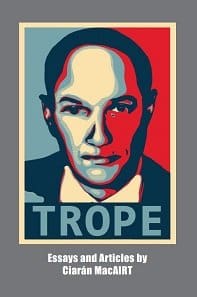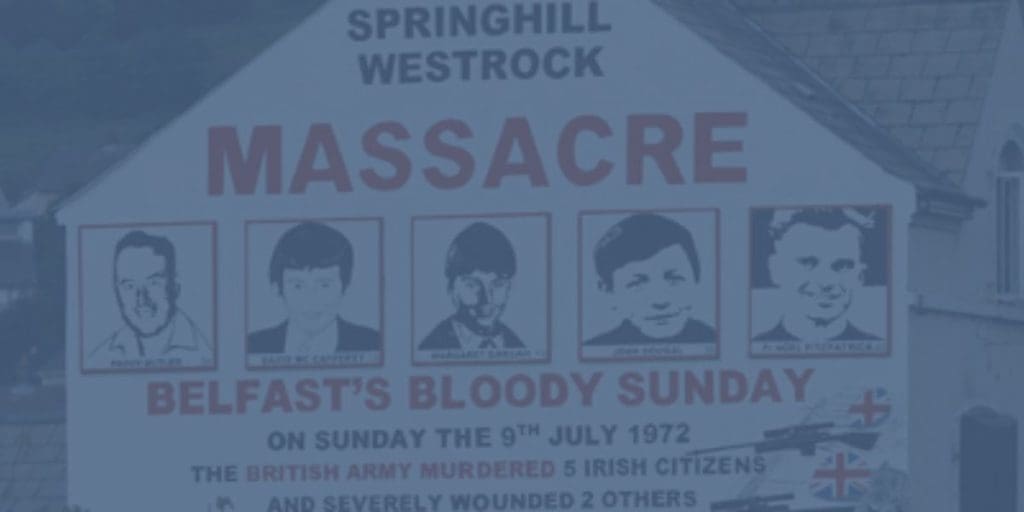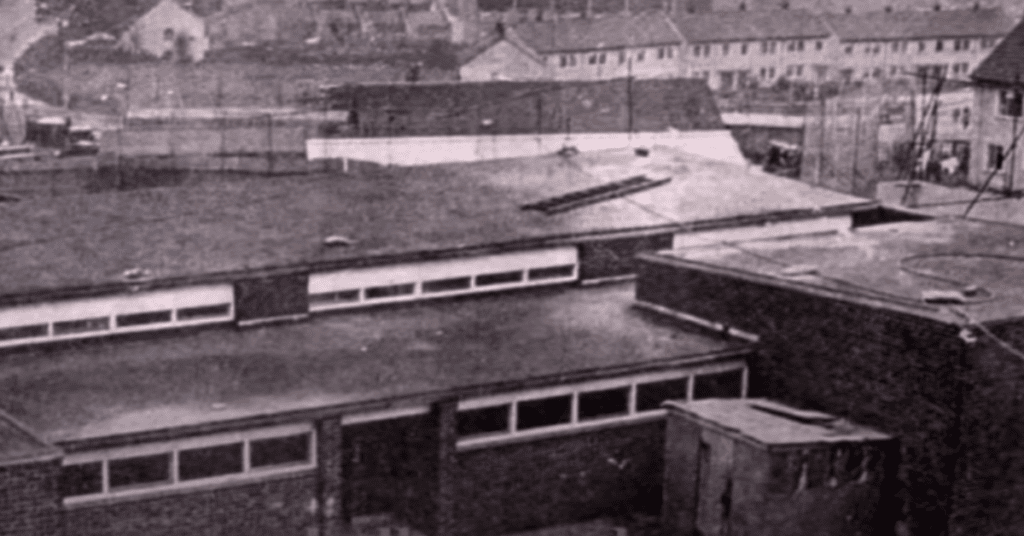The Killer King's Regiment of the British Army.
Paper Trail investigates the Killer Kings who left a trail of devastation in their wake when they left West Belfast at the end of the terrible summer of '72.
A few weeks after Stormont collapsed in March 1972, the North of Ireland erupted in a spasm of violence that spiraled ever downwards until we stared over a precipice in July – the bloodiest month of the bloodiest year of the conflict.
In late April, the King's Regiment of the British Army began its 4-month tour of duty in the Springfield area of West Belfast.
No side was blameless amid the savagery during this period. As well as paramilitary and sectarian viciousness, there was also a rise in overt and covert state killings.
Civilians, as always, bore the brunt of the bloodshed.
Paper Trail has been investigating the secret state archives from these bloody months and supported scores of families over the last 9 years who lost loved ones at the hands of each of the military and paramilitary groups.
This includes new evidence regarding the IRA’s Bloody Friday Massacre which resulted in the mass murder of 9 and injuring of 130 people; and the UVF’s Kelly’s Bar Massacre which resulted in 3 dead and 63 injured.
Paper Trail also supports victims of the British Armed Forces as we have researched the upsurge of unlawful killings by uniformed “Green Army” and undercover, extra-legal forces like the Military Reaction Force (MRF) in the late spring and summer of 1972.
Whilst some may argue that the forces of law and order stopped our descent into the abyss of outright civil war, others may also argue that the British Armed Forces made the situation worse and added to the misery in the place.
What is certain over half a century later is that the British state compounded the grief of victims as it covered up the crimes of its armed forces and agents, and has blocked the families’ equal access to due process of the law up to this day.
No examination of our shared history is complete without a proper understanding of state violence.
Whilst the likes of the Parachute Regiment and MRF have become synonymous with the murder of civilians and subsequent cover-up, Paper Trail has examined other British Army Regiments from the same period that caused similar levels of misery - if not more - over a longer period.
One of those regiments over that terrible summer of 1972 was stationed in the Upper Springfield area from 25th April 1972 to 25th August 1972.
These dates bracketed desperate times in the north and this particular area was one of the most viciously contested at the time. Paramilitary and sectarian violence was rampant, and hundreds of families were forced out of their homes or fled for their own safety.
There is no doubt that the regiment was under tremendous strain as it occupied bases from Whiterock to New Barnsley and tried to deal with violent paramilitary groups, no-go areas, forced civilian movement, and the fraught politics of the day. They also had to contend with an Irish community that resented their presence on their streets.
But this regiment’s motto in Latin is “Nec Aspera Terrent”, snappily translated into English as “Difficulties Be Damned”.
The regiment’s four-month tour of duty came at a terrible cost to its men and their families. 7 of its soldiers lost their lives and 42 were injured[1], many with life-changing injuries.
Their families suffered too. In one terrible incident, the father of one victim hung himself a few weeks after the IRA shot his only son.
Unfortunately, Paper Trail files also prove that when their soldiers were killed and injured, civilians died.
Their victims included young girls, teenagers, local men, and even the local priest.
Nevertheless, many of their killings remain unclaimed to this day.
It is the King’s Regiment - or the Killer Kings as they are now remembered.
[1] A news report from a Kingsman at the time record 80 injured. Patrick Mileham records 42 in his book, Difficulties Be Damned: The King’s Regiment.


VICTIMS
Paper Trail has been working with many of the Killer King’s victims for nearly a decade. We have trawled military archives in London and fought information battles with the British Ministry of Defence that have lasted years.
This new evidence has featured in new inquests for 8 victims of the regiment, with more to come.
Paper Trail discovered British military records from Company level up to Brigade Headquarters and Headquarters Northern Ireland which prove that the Killer King’s Regiment was guilty of civilian deaths that lay unclaimed or were even blamed on others, including the Parachute Regiment, the IRA and Loyalists.
More civilians died at the hands of the Killer Kings than the regiment lost in Belfast during its tour of duty.
Kingsman Alan Buckley was shot dead by the IRA in the aftermath of the Kelly’s Bar bombing on 13th May.
Paper Trail files proved that the King’s Regiment was not only watching the bar when it was attacked by the UVF, but was expecting the car used as the car bomb. The King’s Regiment then supported state disinformation that the bombing was the result of an IRA own-goal, in a re-run of the McGurk’s Bar Massacre lies.
2 died as a result of the Kelly’s Bar bombing and a third some years later 63 were injured when the car bomb exploded so it could have led to a catastrophic loss of life.
A Kingsman was shot and badly wounded by the IRA just past 8pm at Dermott Hill. Within half an hour, local civilian and father of four, Robert McMullan, was gunned down in New Barnsley Park. His murder lay unclaimed although his family and neighbours believed the British Army shot him.
They were right. On the 50th anniversary of Robert’s killing, the family released files discovered by Paper Trail that prove that the Killer Kings deliberately fired at a target in New Barnsley Park at the time Robert was killed.
The following day, 13-year-old schoolgirl, Martha Campbell, was murdered as she walked home on the other side of Springfield Road. Her killing was one of 6 child murders that lay unclaimed throughout the conflict. Again, family and neighbours believed the shots came from British Army positions although the British Army denied it had troops anywhere near the attack.
Again the family was right. Discoveries by Paper Trail proved that not only was the British Army lying, but the same company of Killer Kings (B Company) poured fire into the area that Martha was murdered after claiming the soldiers were firing at an armed target.
Martha's campaigning family and legal team at Ó Muirigh Solicitors have recently been told by the Attorney General that they have won a new inquest - but this may be thwarted by Britain's pernicious Legacy Act which aims to bury British war crimes in Ireland.
Northern Ireland descended into chaos in the weeks after these killings. There were hopes of truce in the last week of June 1972 but state, paramilitary and sectarian violence continued unabated.
On the day truce was announced, 22nd June, Britain's MRF shot 4 civilians on the Glen Road.
A few hours later the IRA shot and injured a Kingsman in north Springfield.
Violence rumbled on and in the opening hours on the eve of the truce, 25th June, the King’s Regiment logged 2 high-velocity shots at one of its mobile patrols in Whiterock/Springfield. At 330am, King’s soldiers logged 3 high-velocity shots at positions in Corry’s timber yard.
Less than an hour later, around dawn break, a mobile unit for King’s Recce Platoon attacked a car nearby and killed its 19-year-old driver, James Bonner.
The Killer Kings alleged that its commander tried to flag it down after they had seen a transfer of a rifle between two cars but Bonner “tried to drive him down.” News reports in the Irish Press the following day carried British Army claims that a shot had been fired at the patrol from the car.
No rifle was found in the vehicle.
One of the two surviving occupants of the vehicle, told the Irish Independent:
“They didn’t shout or wave us down. The first shot was fired from a handgun and grazed my left arm. I dived on to the floor as the bullets were flying all over the place. They must have put 14 shots into the car. The car went out of control and Jimmy Bonner shouted that he was hit. I shouted at the army to stop shooting. A soldier came over and pulled us out of the car and took Jimmy out and laid him on the ground on his stomach.”
The men had been at a wedding that day and had taken the car from one of the party.
The police charged the survivors for taking the car without consent and they got 3 months, suspended for 18. The killer of James Bonner never faced justice.
Springhill-Westrock Massacre
Following prolonged information battles with the British Ministry of Defence, including Public Interest Tests, Paper Trail also secured the Tactical Headquarters logs of the King’s Regiment covering two weeks in July.
At 8pm on 9th July 1972, C Company logged two casualties. A Lance Corporal was shot in the abdomen at the flashpoint Springfield Road/Mayo St. area. A follow-up found 9 x 9mm casings in Elswick Street.
C Company also reported that a Sergeant sustained a gunshot wound to his leg which fractured his femur. This shooting occurred on the Springfield Road halfway between the Monagh roundabout and Kelly’s Bar.
C Company of the Killer King’s Regiment then committed the Springhill-Westrock Massacre within hours. Their victims included another young girl, 13-year-old Margaret Gargan, and the local priest, Fr. Noel Fitzpatrick.
In all that night, C Company of the Killer King’s Regiment murdered 5 and injured 2 as the local people went to each other’s aid. Teenagers David McCafferty (15) and John Dougal (16) – my grandmother’s nephew – were among the dead. Both were members of the youth wing of the IRA - OIRA and PIRA respectively - but witnesses attest that neither Fian was armed. The teenagers bravely went to the aid of their neighbours.
Patrick Butler, a married daddy of 6, was killed by the same Kingsman sniper bullet that felled Father Fitzpatrick as they too went to the aid of the injured.
Reporting from the ongoing inquest, NGO Relatives for Justice wrote just last week that the British Ministry of Defence continues to try to criminalise the local community in order to deflect from the crimes their soldiers.
The Parachute Regiment was long blamed for the Springhill-Westrock Massacre that night and the British Ministry of Defence was content to muddy the waters for decades until the families and their legal team secured a new inquest in 2014.
Paper Trail files proved that it was C Company of the Killer King’s Regiment and yet again the local community suffered soon after Kingsmen were shot.
The same files also prove how the King's Regiment discriminated between the Catholic and Protestant communities in the area at this time. Within hours, Kingsmen captured a teenage Loyalist gunman who was firing across the Springfield Road.
After discussions with the local Ulster Defence Association leader and the Royal Ulster Constabulary, the King's Regiment released the gunman.
Read Casual Collusion and a Tale of Two City Estates
Thomas Mills
Another terrible example of Killer Kings' revenge and cover-up is the murder of Thomas Mills, a Protestant nightwatchman who was shot dead on 18th July 1972.
Kingsman James Jones was 18 years of age when an IRA sniper shot him in the neck as he stood at a sentry post in Vere Foster School. In official British Army records at the time, he is recorded as the 100th British soldier to be killed during Operation Banner.
His family took a double blow a few weeks later when his father, also called James, hung himself after telling his family he would like to be with his only son. He left a wife and four daughters.
Just over an hour later, one of Kingsman Jones’ B Company comrades shot and killed Thomas Mills.
The British Armed Forces blamed his murder on the IRA but Paper Trail files proved that it was committed by B Company of the Killer Kings.
The B Company killer failed to turn up at the new inquest 50 years later and the Coroner recorded that the killing was unjustified and the shooter’s “accounts… which describe a gunman are inaccurate at best and falsified at worst.”
Mills was a family man who left behind a wife and children.
As Martin Luther King said: “Violence begets violence” and this was never truer when we examine the Killer King’s Regiment and its 4-month tour of duty in the terrible summer of 1972.
By the end of the summer, they had lost 7 Kingsmen but as well as being victims, they were victim-makers. The Killer Kings took the lives of more civilians including two schoolgirls and the local priest. Most of these murders were covered up for over half a century and not one Kingsman has ever been held responsible for their killings in a court of law.
The Killer Kings left a trail of human devastation in their wake from the summer of '72 and the families have been fighting since then for truth and justice.
Paper Trail discoveries prove that these series of mass murders and murders should be examined together as they prove that when Kingsmen were killed or injured, the local West Belfast community bore the brunt of their revenge.
Other killings during the period remain unclaimed to this day.

Trope: Essays and Articles
by Ciarán MacAirt.
These essays and articles represent a personal journey, and find him trudging from the killing fields of World War 1 to the back streets of Belfast where death squads prowled.
All of the profits from the sale of this book are donated directly to the charity, Paper Trail, to help fund its work with victims and survivors of the conflict in Ireland and Britain.



